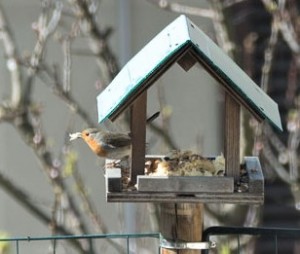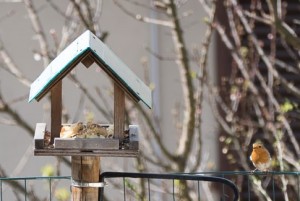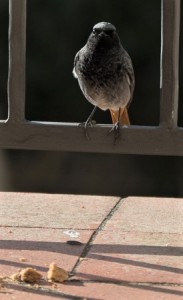I needed a break today, an easy one, so I thought I’d write a post about what is going on in our backyard. Amazing stuff!
 Premise no. 1: Stefano and I love watching and photographing birds…all types of birds…puffins in particular, as you know if you’ve been reading my blog for at least a year. That said, we still aren’t very good at identifying bird species and often need to resort to friends and/or our birdwathing manual, but at least now, after years of birding, we don’t just say: “Hey, did you see that BIRD fly into the yard just now?” but rather, “Hey, did you see that blue tit over there?”
Premise no. 1: Stefano and I love watching and photographing birds…all types of birds…puffins in particular, as you know if you’ve been reading my blog for at least a year. That said, we still aren’t very good at identifying bird species and often need to resort to friends and/or our birdwathing manual, but at least now, after years of birding, we don’t just say: “Hey, did you see that BIRD fly into the yard just now?” but rather, “Hey, did you see that blue tit over there?”
Premise no. 2: we have been trying for years to attract birds into our back yard. With absolutely zero success.
And we don’t kid around, either: every time we go to the U.S., we go to the (famous) Bird Watchers’ General Store in Orleans MA, and return to Florence “armed” with new bird feeders that we naively believe will attract even the most diffident birds. Hah. Forget it. Not even once. One time we even bought some special U.S. bird seed that was guaranteed to attract all sorts of birds from miles around. Didn’t work, either.
The simple and unfortunate fact is that birds in our neighborhood, like most Italian birds, are not used to being fed. Feeding birds is simply not an Italian hobby, generally speaking, although one of my closest friends has been feeding generations of robins with bread, cake, and cookie crumbs that she simply tosses onto a ledge outside her kitchen window. The robins are so tame by now that all she has to do is open the window and whistle, and they come flying down to the ledge. For years, I was soooo jealous of her robins.
I also have an Italian friend who is an expert birder. He has proper feeders at his house, which is out in the country, and is always telling us about all the birds he’s been feeding.
But the thing is, I’ve never seen a proper bird feeder in anyone’s garden over here. The only place where I’ve seen birds being seriously fed is at the bird reserve just outside of Florence, the place where Stefano and I have taken all our photos of the black-winged stilts.
It’s really too bad, since we have fantastic birds over here…Italians should really pay more attention to their, er, birds…
Anyway, this winter everything changed. We had a rather prolonged and unusual cold (i.e., below freezing) spell here in Florence in January, and the various birding organizations made urgent appeals to feed the starving, frozen wild birds. We wanted to help, of course. But how?
Well, one day, back in January, I noticed a couple of birds (to be exact a yellow wagtail and a black redstart) hopping around on our kitchen terrace, looking unhappy and pecking around at…nothing. I grabbed a slice of panettone (a typical Italian Xmas cake, with raisins and whatnot) and took it outside. Almost the second I’d gotten back indoors, the birds were on top of the panettone, gorging themselves.
Yay!
And so my daily bird feeding routine began. I asked for and received panettone presents from our friends, and in fact, thanks to them, I still have some, and it’s March!!!
But I was worried about Romeo (see my Feb 19 post), the outside cat who sleeps in a shelter on our terrace. I decided to move the panettone, which I’d by then put inside containers so it wouldn’t get dirty, off the terrace and over to a safer spot in our backyard. One of our heretofore unused bird feeders, built for us by our birdwatcher friend in fact, is stuck on top of a tall post and is shaped like a little house. Its little roof, as you may be able to see in the photos, protects seeds and panettone from rain and even wind. For years its only inhabitants had been spiders. I decided that it was time to train the birds to use the little house, which, by the way, is open on all sides. 
It didn’t take long for the birds to figure out that their panettone had moved to the bottom of the garden. I ordered some wild bird seed from Germany and added that to the mix, too.
So we finally have birds now…right in our back yard. And our binoculars are finally being used at least five or six times a day, more on weekends. The birds are still a bit camera-shy, so Stefano and I are thinking of setting up some sort of hide on the terrace when the weather gets warmer…
And I already have a plan for when we run out of panettone: I will buy some “colomba,” a typical Italian Easter cake shaped like a dove. It’s very similar to panettone, in my view, so the birds should love it. Right after Easter, I’m going to be buying as many “colombe” as possible during the two/three-for-one sales. Anything to make our birds happy…and to keep them coming to our yard.
The first two photos show our bird house and one of the robins. In the first photo, which I took through the dining room window (so it’s not very clear), he’s got some panettone in his beak. I tried to get a better shot, so I quietly went outside and stood very still for about a half hour, but the robin was still very wary and stayed on the fence to the right. The third photo shows one of my favorites, a very smart little bird, the black redstart, staring straight at me. Again, photo taken through the window…not very clear.
Here’s a list of the birds that have been eating in our bird house, thus far (the ones I’ve seen and been able to identify, anyway):
- European robin
- Black redstart
- Yellow wagtail
- Dunnock
- Eurasian blue tit
- Great tit
- Eurasian blackcap (I think)
- Common blackbird
- Sardinian warbler (seen on March 30)
P.S. Do you have any birding tips for me? 🙂